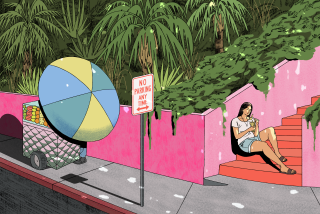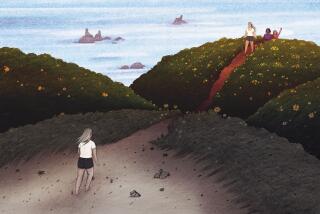For middle-age set, ‘Leap!’ is barely a hop
- Share via
WHY is it that so many authors with recent books about middle-age life (Arianna Huffington, whose subject is women and courage; Deirdre Bair, divorce; and Caitlin Flanagan, parenting), think that their experience is useful for the rest of us?
Sara Davidson, in her book “Leap! What Will We Do With the Rest of Our Lives?” sets out to ask questions that she feels are universal to women of a certain age: How does a high-powered person learn to climb down the ladder gracefully? How can women continue to be sensual and not touch-deprived? How do we arrange to grow old with our friends? These are interesting questions that do not have simple answers. But for Davidson to propose definitive or even useful answers based on data she’s gathered from interviewing a select group is worrisome. It may be OK for magazine articles and TV talk shows, but not for books.
Even the author, at times, fails to benefit from her own prescription. “This book has been so engrossing that it’s given shape and propulsion to my days,” Davidson writes about the three years she spent working on “Leap!” “I’m afraid it’s a temporary fix. When the research and writing are over, I’ll be back where I was before.” Trouble is, her readers have the same problem. After perusing a book like “Leap!” you’re right back where you started. No matter how many anecdotes about people who make tremendous changes late in their lives -- Davidson interviewed 150 people for this book -- if they almost all come from the same socio-economic background, and it’s not the one you inhabit, let’s face it, their options are not your options.
In one of “Leap!’s” early interviews, Davidson asks the Doors’ keyboardist Ray Manzarek how he feels about the fact that his “most well-loved work was done more than thirty years ago.” His answer, something about the inevitability of death and living life to the fullest, is not very helpful. Davidson digresses, inserting herself as she does in most of the book’s interviews, and asks him if he still does psychedelics. “That’s for your twenties and thirties,” he tells her smugly. “Once you open the doors of perception, they stay open.” “Not for some,” Davidson replies. “The doors clanked shut when they became workaholics and tried to be superparents.”
This exchange is interesting because it illustrates how Davidson limits herself, perhaps after too many years writing for magazines. Rather than let herself truly run across the economic and social spectrum asking the big questions, Davidson confined herself, as if she were writing lifestyle articles, to questions: How many marriages is too many; why can’t people in their 50s and 60s and 70s have all the sex they want and feel they deserve, and, heaven help us, should we indulge in plastic surgery?
These questions mirror the fallacy of talk-show psychotherapy, which presumes to tell us exactly what we have a right to expect from life. Gathering a bunch of stories under chapter titles that come directly from the author’s personal experience (cleverly concealed in song lyrics); traveling around the country reconnecting with old friends from the ‘60s and asking them about the choices they’ve made, then making those stories into a book requires an annoying amount of hubris.
And yet, it has long been Davidson’s modus operandi, a combination of personal therapy and anecdotal evidence. The sources in her 1977 book, “Loose Change,” which told the story of three women (one of them Davidson) attending Berkeley in the 1960s and the saga of how they became political and radical, were in roughly the same income and age brackets as she.
In “Leap!” Davidson interviews, among others, Cheryl Tiegs, Jodie Evans, Jane Fonda, Danny Goldberg, Andrew Weil, Carly Simon and Gloria Steinem. These people have the luxury and the time to wallow in spiritual growth and midlife crises: What should I do next? How can I contribute after a life of consumption? If I feel that my life has gotten off-track, that I’ve made the wrong choices, how can I get back on track? These are fabulous, even important, questions to ask oneself. But picking up and moving, jobless, to another town; checking into an ashram for a few decades; leaving the fast lane for a condo and some psychedelic drugs in Hawaii are not options for most of us. Personal happiness is not the sole ingredient of fulfillment.
This reviewer is Davidson’s target audience. Most of the women I know are in the process of having either their kids, their livelihood or their lovers “yanked,” as Davidson puts it, out from under them, although maybe not, as happened to the 64-year-old author, all at once. Davidson, annoyed that magazine editors no longer jump at her story ideas, bemoans the fact that her reputation doesn’t always precede her.
There are illuminating moments: Bebe Moore Campbell, in an interview before her death, says that she learned in late middle age, to “shift from achieving to nurturing.” Davidson, after a ritual designed by female friends in Boulder, Colo., to help her get through her 60th birthday, is asked, by those friends, several questions about what has mattered most to her throughout her life. “Love,” she realizes, “was the answer to all the questions.” Sally Kempton, who left L.A. to live in an ashram for 30 years and then returned to civilian life, describes the feeling of happiness unrelated to relationships or things that she was given an unforgettable taste of: “The closest analogy I have is that heart-melting feeling you have when you’re in love, when the world seems fascinating and you take pleasure in simple things.”
In a novel, these lovely quotes and insights would be set in a rich context of personality and situation and culture. Robbed of a context beyond the author’s personal quest for happiness, they are almost too shiny for the reader to absorb.
*
More to Read
Sign up for our Book Club newsletter
Get the latest news, events and more from the Los Angeles Times Book Club, and help us get L.A. reading and talking.
You may occasionally receive promotional content from the Los Angeles Times.






